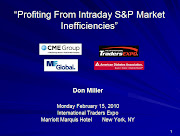This is because in my view, stalking and effectively managing positive outliers is one of the most critical aspects of trading that pattern gurus fail to address.
What do I mean by positive outliers? Those one or two trade "sequences" over the course of a day, week, month, year, or career ... that skews the P&L to the "P" side, while buying you (1) bait for subsequent "fishing" trades and (2) time to stalk the next trade. You can do a blog search in the top left corner to find several posts addressing outliers.
And it's key on both a micro and macro perspective.
For example, on the macro front, we need look back no further than between late 2007 and early 2009 where I essentially bought over twenty years of six-digit income in about 15 months.
For example, on the macro front, we need look back no further than between late 2007 and early 2009 where I essentially bought over twenty years of six-digit income in about 15 months.
 And on the micro front, today provided another solid example, when as is usually the case for me, it took a while to get my Monday motor running before essentially earning today's entire net on the single trade sequence on fading yet another noon push as noted on the attached time-based P&L chart (click to enlarge) -- which btw I've really found often best illustrates my trading day.
And on the micro front, today provided another solid example, when as is usually the case for me, it took a while to get my Monday motor running before essentially earning today's entire net on the single trade sequence on fading yet another noon push as noted on the attached time-based P&L chart (click to enlarge) -- which btw I've really found often best illustrates my trading day.So whether it be one highly dedicated period of time during a career, or one trade sequence over the course of the day, it's all and only about stalking the positive outlier.
Oh, I could have traded better today, including both increasing the results of the noon outlier and taking a few other trades which I read well as the new week's engine was getting cranked up.
Yet as the Celtics will tell you, I'll take today's somewhat sloppy win to continue the "in-tank" trading streak, and simply come back on the court again for the next game.
The only difference is that in trading, the cumulative scores of each game do count in the standings.
In fact, the cumulative scores are the standings.
















6 comments:
Off topic in a way...but about the stalking I was doing
In terms of the trades you make, who is on the other side of those trades? Is it an entity, opinion, emotional trading, all of these things? Is thinking about the other side of a trade a manner to think about why the entry is low risk at that point?
I ask as I have just started following emini futures, saw overnight market range of 1120-1140, thought that a low risk entry of the day was to fade either extreme if it was hit, and then take some profit. At open, the market went just over 1140 and then retraced back down (I traded an SDS option and stock). It is tough to conceptualize who is on the other side of that, other than the bulk of market participants that stopped buying.
Thank you.
Don, what do you consider an avg outlier in terms of ES points? 2, 3, 4?
I believe you add to winners as the trade moves in your direction so I was wondering from your avg to exit how many ticks you usually exit at?
Stan -
There's no rule as market conditions and volatility vary daily. Essentially, I seek wholesale opportunities during times of market inefficiencies that are likely to correct, and the profit potential varies based on setup.
Don
Nursebee -
That's a mouthful and I'm not sure I understand the question.
There are many different market participants, but essentially if the intraday entity on the other side of the trade is wrong, they'll have to take action which will further drive the market in your direction.
Don
Forgive me for speaking with a full mouth.
Somewhere, I thought here, it was suggested to know who is on the other side of the trade. If I choose to follow NFLX or BIDU, I can read the chart and have a sense of the buying and selling action, and if they continue to go down, quite a few have bought higher than this and will sell fast and hard.
For futures and ETFs, I find it difficult to picture who is on the other side of the trade (and why).
I picture the intraday entity as a collection of market participants.
Hi Don,
Interesting topic.
I am curious, do you use any kind of standard deviation or similar idea to define these outliers or is it more by your "years of experience?"
Thank you
Post a Comment